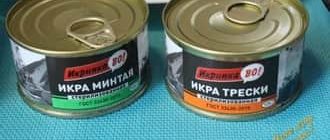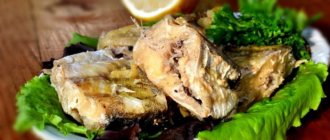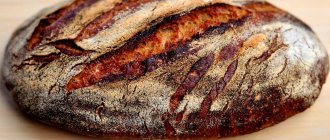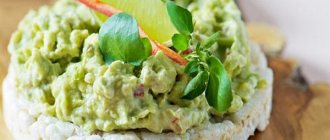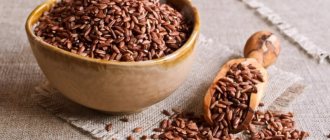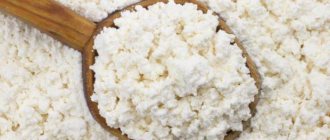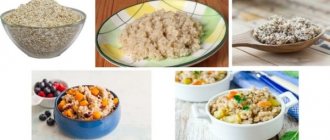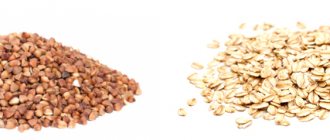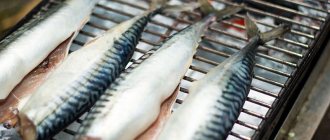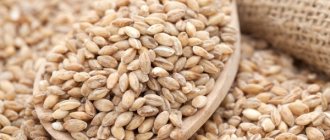BZHU and calorie content of pollock
This product has a low calorie value.
Let's consider how it changes, depending on the method of preparation, per 100 grams of product:
| Type of cooking | Calorie content, kilocalories |
| stewed | 75 |
| boiled | 79 |
| fried | 127 |
| Breaded | 131 |
| dried (dried) | 259 |
The calorie content of fresh pollock is 72 kilocalories. And also per 100 grams of product there are:
- 16 gr. proteins;
- 0.9 gr. fat
Contains saturated fatty acids, does not contain carbohydrates.
Table
| element name | quantity | daily norm | |
| The nutritional value | |||
| Calorie content | 72 mg | ||
| Squirrels | 15.9 g | ||
| Carbohydrates | 0 | ||
| Fats | 900 mg | ||
| Vitamins | |||
| Vitamin B3 | 1.3 mg | 15.059 mg | |
| Vitamin B2 | 0.11 mg | 1.329 mg | |
| Vitamin PP (NE) | 4.6 mg | 15.059 mg | |
| Vitamin B1 | 0.11 mg | 1.159 mg | |
| Vitamin E (TE) | 0.3 mg | 10.882 mg | |
| Vitamin C | 0.5 mg | 69.118 mg | |
| Provitamin A | 0 | 5 mg | |
| Vitamin A (VE) | 0.01 mg | 0.753 mg | |
| Vitamin B5 | 0 | 3.794 mg | |
| Vitamin B6 | 0.1 mg | 1.512 mg | |
| Vitamin B9 | 4.9 mcg | 285.9 mcg | |
| Vitamin H | 0 | 0.034 mg | |
| Vitamin A | 0.01 mg | 0.753 mg | |
| Vitamin E | 0 | 15 mg | |
| Vitamin B12 | 0 | 3 mcg | |
| Vitamin B4 | 0 | 500 mg | |
| Vitamin D | 0 | 0.011 mg | |
| Vitamin K | 0 | 0.085 mg | |
| Macronutrients | |||
| Calcium | 40 mg | 987.5 mg | |
| Magnesium | 55 mg | 276.177 mg | |
| Sodium | 40 mg | 948.824 mg | |
| Potassium | 420 mg | 1807.143 mg | |
| Phosphorus | 240 mg | 852.941 mg | |
| Sulfur | 170 mg | 1000 mg | |
| Silicon | 0 | 30 mg | |
| Microelements | |||
| Iron | 0.8 mg | 13.75 mg | |
| Chlorine | 165 mg | 2300 mg | |
| Copper | 0.13 mg | 0.806 mg | |
| Manganese | 0.1 mg | 2 mg | |
| Fluorine | 0.7 mg | 3 mg | |
| Bor | 0 | 1.4 mg | |
| Aluminum | 0 | 40 mg | |
| Titanium | 0 | 0.85 mg | |
| Strontium | 0 | 1.5 mg | |
| Iodine | 0.15 mg | 0.131 mg | |
| Zinc | 1.12 mg | 9.706 mg | |
| Chromium | 0.055 mg | 0.034 mg | |
| Molybdenum | 4 mcg | 70 mcg | |
| Vanadium | 0 | 0.01 mg | |
| Cobalt | 0.015 mg | 0.1 mg | |
| Nickel | 7 mcg | 100 mcg | |
| Rubidium | 0 | 0.2 mg | |
| Lithium | 0 | 0.2 mg | |
| Selenium | 0 | 0.04 mg | |
| Tin | 0 | 0.7 mg | |
| Zirconium | 0 | 0.5 mg | |
| Other elements | |||
| Alimentary fiber | 0 | ||
| Organic acids | 0 | ||
| Water | 81.9 g | ||
| Mono- and disaccharides | 0 | ||
| Ash | 1.3 g | ||
| Alcohol | 0 | ||
| Starch | 0 | ||
| Saturated fatty acids | 200 mg | ||
| Cholesterol | 50 mg | ||
| Unsaturated fatty acids | 0 | ||
This table shows the average norms of elements for an adult.
Chemical composition and beneficial properties
In addition to fats and proteins, pollock contains vitamins A, PP, C, E, group B, the entire range of microelements and macroelements that determine its benefits:
- A high content of the active form of iodine has a positive effect on the functioning of the thyroid gland, brain, and central nervous system.
- Phosphorus and fluorine contribute to the good condition of teeth, bones, hair, and nails.
- Potassium strengthens the heart and fights swelling.
- Selenium is an antioxidant, responsible for cell youth, and maintains normal blood sugar levels.
- Cobalt accelerates carbohydrate metabolism.
- Fatty acids fight “bad” cholesterol.
Note! From this we can conclude that any person who cares about their health needs to use this product.
The benefits and harms of pollock
Beneficial properties of pollock for the human body
How is pollock useful for the human body? Yes, a lot! Containing a significant amount of substances useful to humans, pollock is almost the most accessible fish for the general population. Pollock is very simple to prepare, does not require any special frills, and at the same time perfectly regulates metabolic processes in the human body. In particular, this fish has pronounced antioxidant properties, and is also vital for diabetics (as a blood sugar regulator).
The combination of iodine and chromium in one product is an excellent opportunity to regulate the condition of patients with diabetes. Pollock should be a regular dish in the diet of such patients, since chromium regulates lipid and carbohydrate metabolism, thereby normalizing blood sugar levels. In addition, being a stimulator of the production of certain enzymes, chromium can affect heredity.
Photo of pollock meatballs in cream (in the oven): see recipe
As for the amount of iodine in a pollock carcass, there is enough of it so that, with regular consumption, you will forever forget about the deficiency of this microelement in the body (as well as about problems with the thyroid gland). Because to satisfy a person’s daily need for iodine, only 100 g of pollock is required (both benefits and savings!).
Let us also note that iodine is useful not only for the thyroid gland. By normalizing the production of thyroxine (hormone), this microelement regulates the functioning of the cardiovascular system, liver and central nervous system. Moreover, thyroxine serves as a regulator of a person’s emotional state! Therefore, with a lack of iodine, it is possible to develop a depressive state during the recovery period of a person after certain types of diseases.
Photo of pollock in an omelet (in the oven): see recipe
In addition, pollock is also useful for the mucous membranes of the digestive system and has a beneficial effect on the balance of the nervous system. Being a fish of the northern seas, pollock contains vitamins that allow the human body to quickly recover from illnesses and injuries. Pollock proteins are easily digestible, and the presence of polyunsaturated fatty acids (even in small quantities) improves the functioning of the gastrointestinal tract and liver.
The presence of cobalt in the meat of this fish (in 100 g - 150% of the daily requirement) once again confirms the benefits of pollock for the human body. Because cobalt regulates carbon metabolic processes in the human body, promotes the absorption of iron (thereby reducing the risk of anemia), and is also an important part of the blood clotting mechanism.
Photo of pollock fish cutlets with bread: see recipe
Potassium makes pollock an excellent “removal” of excess fluid from the body. Fluoride strengthens bone tissue. Therefore, pollock is very useful for older people with “light” bones and frequent fractures. On top of that, pollock should be included in the diet of young children at least once a week for natural caries prevention.
And finally, the combination of phosphorus and potassium increases the efficiency of brain activity and has a beneficial effect on the acid-base balance.
It seems that pollock is beneficial for the entire human body...
Potential harm to pollock
Pollock can cause harm to humans only in two cases:
- if a person has an individual intolerance to seafood and any fish
- pollock will be caught in the chemically polluted waters of the world's oceans (which may well happen, given the recent events in Japan, not far from where it is most often caught)
Otherwise, pollock is completely and completely safe. The main thing is not to give it to children before 8 months - there is a chance of developing an allergy.
Photo of pollock with carrots and onions in tomato sauce: see recipe
How to choose the right fish?
To buy a quality product, and not “second-fresh sturgeon,” you need to be able to choose it correctly.
Signs characteristic of fresh fish:
- transparency, protrusion of the eyes;
- no ammonia smell;
- red gills;
- no sagging or bloating of the abdomen;
- shiny, dense scales;
- elasticity (there are no traces left when pressing a finger on the fish).
Note! If you buy frozen fish, you need to pay attention to the presence of tears, spots on the skin, and unnatural shape. If these signs are present, it means that it has been frozen many times; you should not purchase it due to the loss of beneficial properties.
Pollock recipes
The range of dishes from it is very large. It is delicious fried, cooked with cream and other fatty sauces. This article offers recipes that are suitable for people watching their weight.
Baked pollock
The recipe is very simple. Preparation takes only 30 minutes.
You will need the following products:
- 300 gr. pollock fillet;
- salt, pepper to taste;
- 1 tsp. lemon juice.
Preparation:
- Salt and pepper the fish, sprinkle with lemon juice, and carefully wrap in foil.
- Place in a baking dish and bake for 30 minutes.
- The oven temperature should be 180 °C.
For a richer taste, the dish can be made with vegetables.
Pollock with bell pepper and tomatoes
Ingredients:
- 300 gr. pollock fillet;
- 3 pcs. tomato;
- 3 pcs. bell pepper;
- 2 pcs. onions;
- 4 cloves of garlic;
- salt, black pepper to taste;
- vegetable oil 2 tbsp. l.
Cooking method:
- Rub the fish with salt and ground black pepper.
- Cut sweet bell peppers, tomatoes into cubes, onion rings, finely garlic.
- Place the vegetables in a baking dish, add salt and vegetable oil.
- Cook for 20 minutes at oven temperature 180°C, stirring occasionally.
- Place the fish on top and bake for 6 minutes on one side.
- Turn over and place in the oven for another 5 minutes.
Steamed pollock cutlets
An easy, healthy dish. Recommended for children's and dietary nutrition.
Ingredients needed for cooking:
- 0.5 kg pollock fillet;
- 20g. millet flakes;
- 150 gr. onions;
- 2 tbsp. l. cream;
- 1 egg;
- 100 gr. breadcrumbs;
- salt, black pepper to taste;
- 1 tsp each dill, parsley.
Preparation procedure:
- Grind the fillet and onions in a meat grinder.
- Add all other ingredients for minced meat and mix.
- Form cutlets, roll them in breadcrumbs.
- Grease a steamer with oil and place the cutlets.
- Steam for 20 minutes.
Boiled pollock soufflé
To prepare it you need the following products:
- 300 gr. pollock fillet;
- 2 onions;
- 2 pcs. carrots;
- 4 eggs;
- salt, pepper to taste;
- 1 tsp. dry dill;
- 1 tbsp. l. vegetable oil.
Preparation:
- Boil the fillet until tender, cool.
- Sauté chopped onions and carrots in vegetable oil.
- Place the fish, fried onions and carrots, and yolks into a blender and bring until smooth.
- Beat the whites until they form a stable foam.
- Carefully combine the whites with the fish mixture, place it on a baking sheet, after placing it in oiled paper.
- Bake for 30 minutes at 200°C.
A tender, melt-in-your-mouth dish is ready.
The low calorie content makes pollock a product recommended for nutrition not only for those who care about weight, but also for pregnant women, children, and older people.
The benefits of pollock
Pollock has pronounced antioxidant properties. With regular consumption of it, the likelihood of developing diseases of the musculoskeletal system and cardiovascular system is reduced, and the risk of malignant tumors is significantly reduced.
The absence of carbohydrates in pollock meat makes this fish indispensable in the diet of people suffering from diabetes.
Many children's doctors advise including pollock in baby food starting from the age of eight months. This is explained by the fact that this fish is rich in iodine and its regular consumption is an excellent prevention of thyroid diseases. Also for the same purpose, pollock is recommended for pregnant women and nursing mothers, as well as all people living in areas of natural iodine deficiency.
It is difficult to overestimate the benefits of pollock for smokers. The vitamin A contained in large quantities in this fish reduces the likelihood of developing lung cancer.
The beneficial properties of pollock include the fact that the meat of this fish helps reduce cholesterol levels in the blood serum and improves brain activity. These properties are explained by the omega-6 and omega-3 fatty (polyunsaturated) acids contained in pollock.
The low calorie content of pollock allows it to be included in the diet of obese people.
In terms of its nutritional properties, pollock is almost in no way inferior to expensive varieties of fish, and at the same time costs several times less. Nutritionists advise eating dishes made from it at least twice a week.
